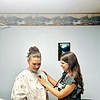Superfund group says state should pay for cleanup work
HAYDEN BLACKFORD | Hagadone News Network | UPDATED 2 years, 11 months AGO
The Libby Asbestos Superfund Oversight Committee met on Dec. 15 and recommended the Montana Department of Environmental Quality pay for the removal of asbestos contamination of a property where the owner had originally not acted on the cleanup.
It was just the second time in the committee’s history that it said the state should pay for cleanup work. The property where the work needs done was initially refused by the property owner.
But recently the owner reached out to the Asbestos Removal Program to get sections of property’s contamination to below 25% of the total property.
The site came before the committee with a designation as a Notice of Environmental Condition (NOEC), said Amanda Harcourt, president of the Lincoln County Asbestos Resource (ARP) program. The property had sampling done, and it was found to have contamination totaling more than 25% of property.
NOEC properties have had a notice of environmental condition and after inspections were performed it was shown the property needed abatement done. NOPEC properties have had notice of possible environmental conditions where no information exists.
Harcourt asked for LASOC’s approval to draft a letter of recommendation for reimbursement of the abatement cost of property. This process has been done once before, so officials noted there is a precedent. Multiple officials noted concern from the public that if abatement is not addressed correctly that contaminants will end up somewhere else.
“I think it’s always been important to us to take care of these properties,” George Jamison said.
Jamison supported the committee making a recommendation to DEQ that abatement be funded through what is commonly referred to as Vincent bill money.
The motion was approved to draft a recommendation from LASOC to DEQ to fund the cleanup at the property, which was unanimously approved by the committee and the DEQ. The bid from the contractor to complete abatement on the property was $19,895.
The committee also discussed the 2022 budget and analyzed reports on asbestos maintenance.
The committee monitors site activities in Libby, assists in implementing final cleanup and long-term operation and maintenance (O&M) plans, reviews documents and provides comments and recommendations to the DEQ, local governments and federal agencies regarding the Superfund site.
The Environmental Protection Agency (EPA) has the lead role overall for the Libby Superfund Site. The EPA is responsible for selecting remedies, remediation and O&M planning.
DEQ collaborates and shares responsibilities with the EPA for overall activities at the Site and is the lead agency for Operable Units (OU) as they enter the O&M phase.
The O&M report was given by DEQ's Jason Rappe and Harcourt.
Harcourt explained that ARP responded to 44 hotlines between September and December, 281 utility locates and 38 site visits.
Harcourt outlined several properties that are awaiting or undergoing abatement in both Libby and Troy after being inspected for asbestos contamination.
Harcourt spoke about work at the Asa Wood School.
"Abatement for the Brownfield Project is ongoing and the final inspection is Jan 10," Harcourt said.
A Brownfield project is one that requires remediation before the land can be reused for another purpose.
The scope of work for demolition of the west wing of the school is on hold for now for three main reasons, including that demolition can't be done in winter, the DEQ is unsure of whose hands the property will be in when the project can move forward, and the DEQ is also unsure of whether the roof can be removed or not, which could affect exposure during abatement.
The DEQ will be using EPA grant funds to pay for the cleanup at the school.
Rappe also provided a site update for activities on the Libby mine sites (OU3) and OU6. The DEQ is still working on a feasibility study of OU3, according to Rappe. According to the EPA’s website, the EPA is currently evaluating different treatment technologies that could be implemented to reduce exposures to Libby Amphibole in soil, duff, water, sediment and mine waste.
For OU6, or the 42 miles of rail-line, the BNSF railroad submitted to EPA and DEQ their annual inspection report. Nothing about that report stood out, Rappe said.
“Everything they're doing they're doing as they laid out,” Rappe said.
ARTICLES BY HAYDEN BLACKFORD

Flower Lake Road paving enhances access to recreation
Thanks to the perseverance of the Libby Outdoor Recreation Association, a section of Flower Lake Road is now paved.
The brouhaha over BORZ designations in Lincoln Co.
What are BORZ and what do these designations mean?

Young professional spends summer aiding Libby Clinic
The disparity between urban and rural healthcare is something that organizations are trying to bridge with exposure.
